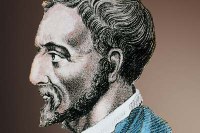In his autobiography, Cardano wrote of himself “I am not very respectful and do not mince words”. His life-long, unmitigated frankness often drew accusations from and resulted in clashes with his colleagues, students and even the Inquisition. Although his life was difficult and troubled, he wrote countless theoretical works in which the Renaissance is justified through the search for the whole in the individual.
 Gerolamo Cardano was born in Pavia out of wedlock. His father Fazio, a Milanese jurist and renowned mathematician, fell in love with the widow Chiara Micheri, who already had three children. Those three siblings died in the plague, and the woman tried to abort, as Gerolamo wrote in his autobiography.
Gerolamo Cardano was born in Pavia out of wedlock. His father Fazio, a Milanese jurist and renowned mathematician, fell in love with the widow Chiara Micheri, who already had three children. Those three siblings died in the plague, and the woman tried to abort, as Gerolamo wrote in his autobiography.
His childhood was very hard, but the young man managed to pursue his interest anyway. After studying at the universities of Pavia, Mantua and Padua, he took a degree in liberal arts from the University of Venice, followed by a degree in medicine in 1526.
His illegitimacy prevented him from entering the College of Noble Physicists in Milan in 1529, but ten years later, thanks to the support of the Borromeo family, members of which had been his patients, he obtained a post at the Milan College of Physicians.
He taught medicine at the University of Pavia from 1543 to 1562.
During that period, he often found himself the rival of colleagues and professors from other universities. His most famous clash followed the 1545 publication of his Ars Magna, in which he attempted to solve and explain the cubic and quartic equations. Cardano did not claim to have solved these problems himself, attributing the former to Niccolò Tartaglia, a professor at Verona at the time, and the latter to Ludovico Ferrari, his student and assistant. Tartaglia accused him of having published his discovery without his permission, but Cardano rebutted that, according to some, the Bolognese Scipione del Ferro had actually been the one to first solve the equation. A public dispute erupted between the two that was resolved in the end by naming the solution the Cardano-Tartaglia formula.
In the meantime, the by-now famous physician was flooded with invitations and commissions, bringing him as far as the courts of England and Scotland. It is said that his visit to the Tudor king Edward VI had left such an impression that it inspired Prospero, the protagonist of Shakespeare’s play “The Tempest”.
In 1560, his life peppered with successes and undermined by accusations and calumny, he suffered a sudden blow: his son, also a physician, was condemned to death for the crime of poisoning his unfaithful wife.
In 1562, plagued by conjecture over presumed illicit relations with a few of his students, Cardano left the University of Pavia, where he had taught for nearly twenty years, transferring to the University of Bologna, where he was supported by Carlo Borromeo, papal legate at the time and patron of the university.
But he found himself having to deal with academic traps and family problems there, as well.
His son Aldo, after stealing from him, publicly reproached him, but was condemned and forced to leave the city.
During that same period, the accusations of heresy became increasingly threatening, undoubtedly born out by Cardano’s close friendships with distinguished Protestant thinkers and ties to unorthodox Catholic currents in Italy. The bold horoscope that he had cast for Jesus and his admiration of Nero, considered by the Church to have been an exterminator of Christians, certainly did not pass unobserved. And so, he was arrested in 1570 and recanted the following year.
The intellectual value of his confessed crime made it possible, however, for him to take refuge in Rome, under the protection of Pius V and then Gregory XIII, the latter his greatest Bolognese admirer. To thank his benefactors, Cardano burned more than 120 texts, deemed too far removed from Catholic truths.
In 1575, he managed to enter the College of Physicians in Rome, but, by this point, elderly and world weary, he began to withdraw increasingly into private pursuits, devoting the final year of his life to writing his autobiography, published posthumously in 1643.
1663 saw the publication of his vast Opera Omnia: ten volumes containing more than 200 texts, filled with the passion and effort devoted by the erudite Neoplatonist to the search for truth in the multiple, his interest in the abstract and the immanent and his continuous testing of the limits of man.
